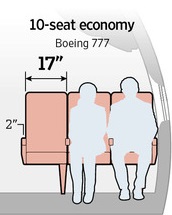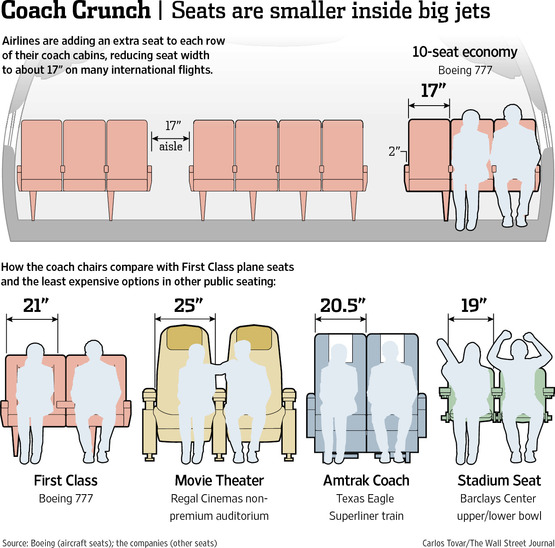Oh, the allure of business class. Flat-bed seats, on-board chefs and the comfort of privacy are all high-paying fliers need to justify the cost.
And while air travel in general has digressed, the opposite can be said for Business Class cabins. The cabin, created around 1978, initially offered little in additional comfort and minimum thrills. These days, those coveted beds in the air are well worth their weight in gold.
So, how do you expand higher-fare sections without dropping passenger capacity?
The airlines giveth, and then they taketh away.
Big carriers like American Airlines, United Airlines, Air Canada and Air France are all cast in the ‘Incredible Shrinking Airline Act’ — wedging an extra seat into each coach row by cutting into shoulder space and limiting seat width to a mere 17 inches.
But, with time comes progress, right? Not when it comes to economy class. This new trend reverses the previous half-century of seat growth. Early jet planes had 17-inch seats, based on the width of a U.S. Air Force pilot’s hips.
While Americans are globally infamous for being obese, are airlines expecting too much by holding them up to the standards of an Air Force pilot, whose job it is to stay in shape?
But it’s not just the seat width. Arm rests and aisles aren’t excluded, as they’ll be getting the slim-down treatment as well.
Even JetBlue, the airline with ‘the most legroom in coach’, is cutting an inch of said legroom for its long-haul flights to make room for Business Class passengers commuting from New York to Los Angeles and San Francisco. Coincidentally, JetBlue will still retain its title, despite the missing inch.
We live in a world where one inch can feel like an upgrade.
And while seats are designed more ergonomically with better cushions and headrests, the shrinking widths and legroom doesn’t sit well with most travelers, especially those who are large or overweight.
“We are mindful that we serve a wide range of customer types and our aircraft[s] need to be configured accordingly,” vice president of marketing for United-Continentals Holdings Inc., Tom O’Toole, told The Wall Street Journal. He also said the airline brings in real people of all shapes and sizes to help test the seats.
Kind of hard to believe, considering the military personnel-sized seat width.
The solution? Pony up more money —significantly more — or expect and accept less overall comfort, including, but not limited to, more bumps from shoulders, service carts, other people’s luggage and the seat in front of you.

 Save up to 60% on Business Class. Call 1-800-435-8776
Save up to 60% on Business Class. Call 1-800-435-8776


Leave A Comment